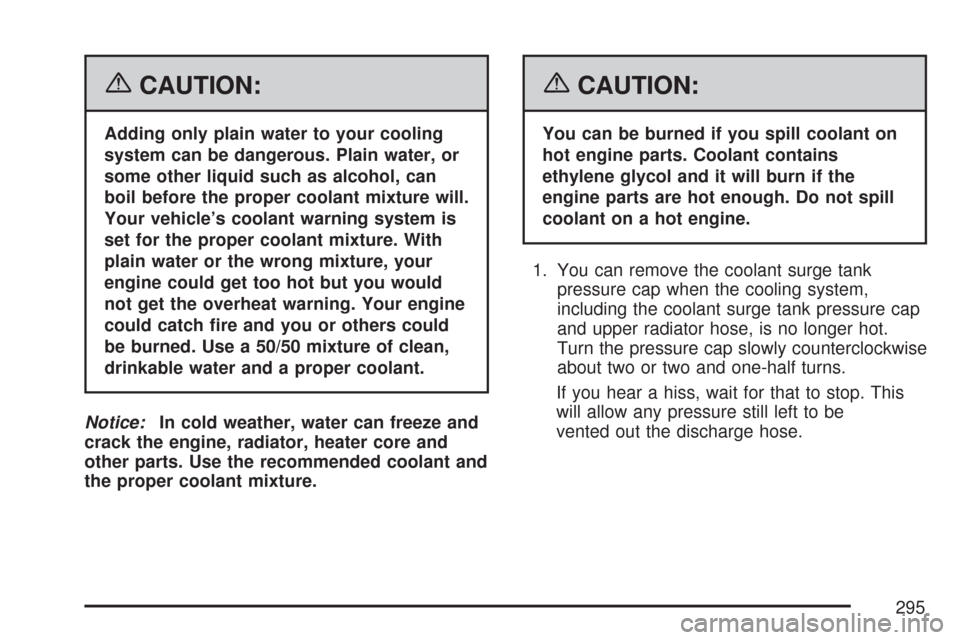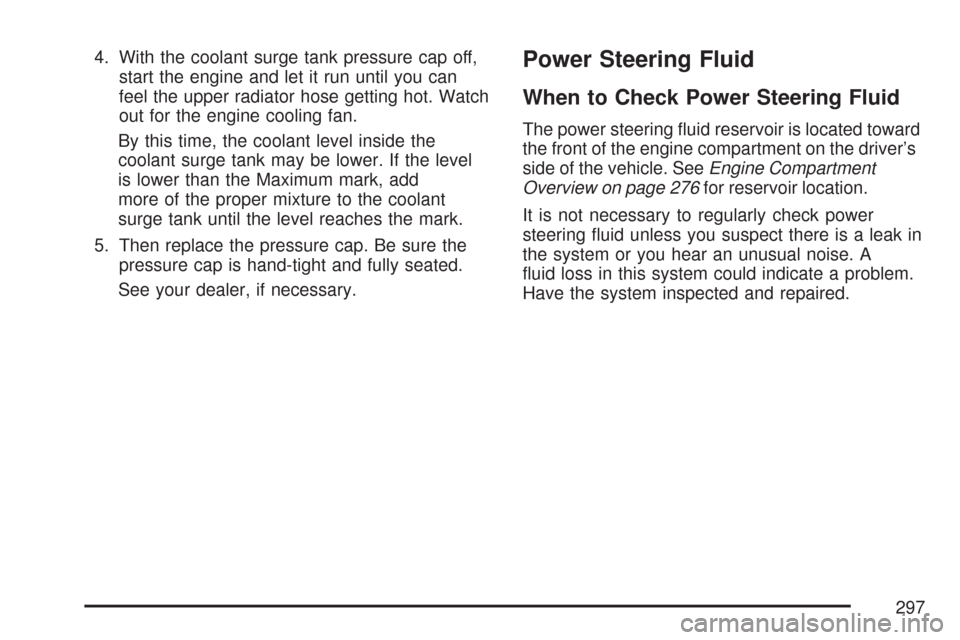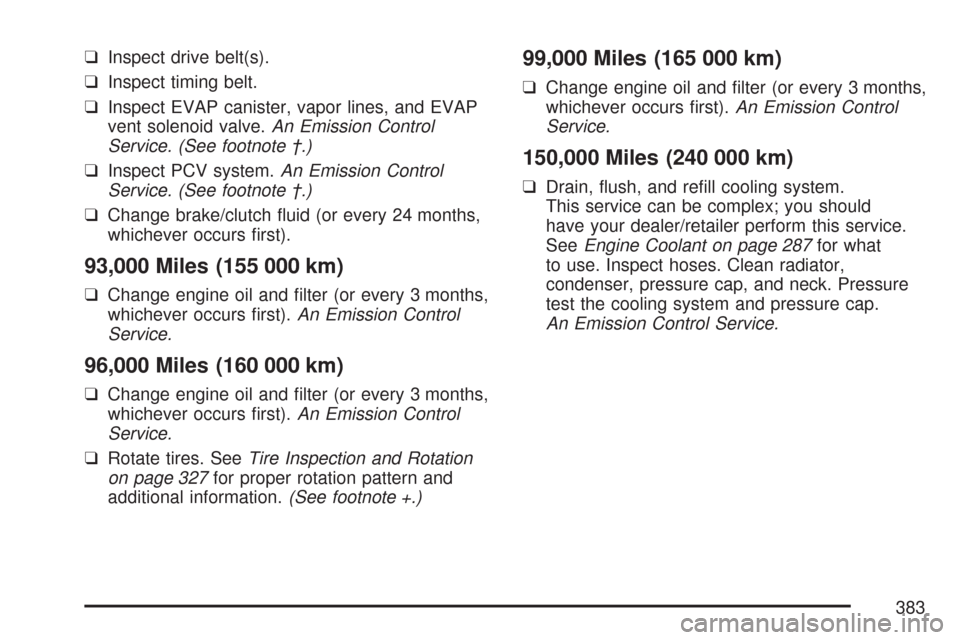Page 289 of 436
Checking Coolant
The engine coolant surge tank is located in the rear
of the engine compartment on the driver’s side of
the vehicle. SeeEngine Compartment Overview on
page 276for more information on location.
{CAUTION:
Turning the surge tank pressure cap when
the engine and radiator are hot can allow
steam and scalding liquids to blow out
and burn you badly. Never turn the surge
tank pressure cap — even a little — when
the engine and radiator are hot.
To check the engine coolant, the vehicle must be
on a level surface. When your engine is cold,
the coolant level should be between the
Maximum (A) and Minimum (B) marks on the
coolant surge tank. The level rises at engine
operation temperature and drops again when the
engine cools down.
289
Page 293 of 436

{CAUTION:
An electric engine cooling fan under the
hood can start up even when the engine
is not running and can injure you. Keep
hands, clothing, and tools away from any
underhood electric fan.
If the coolant inside the coolant surge tank is
boiling, do not do anything else until it cools down.
To check the engine coolant, the vehicle should
be parked on a level surface. Make sure that
the air conditioning is turned off.
The coolant level should be between the Minimum
and Maximum marks on the coolant surge tank
when the engine is cool. If it is not, you may have
a leak at the pressure cap or in the radiator
hoses, heater hoses, radiator, water pump, or
somewhere else in the cooling system.
{CAUTION:
Heater and radiator hoses, and other
engine parts, can be very hot. Do not
touch them. If you do, you can be burned.
Do not run the engine if there is a leak. If
you run the engine, it could lose all
coolant. That could cause an engine �re,
and you could be burned. Get any leak
�xed before you drive the vehicle.
If there seems to be no leak, with the engine on,
check to see if the electric engine cooling fan
is running. If the engine is overheating, the
fan should be running. If it is not, your vehicle
needs service.
Notice:Engine damage from running your
engine without coolant is not covered by your
warranty.
293
Page 295 of 436

{CAUTION:
Adding only plain water to your cooling
system can be dangerous. Plain water, or
some other liquid such as alcohol, can
boil before the proper coolant mixture will.
Your vehicle’s coolant warning system is
set for the proper coolant mixture. With
plain water or the wrong mixture, your
engine could get too hot but you would
not get the overheat warning. Your engine
could catch �re and you or others could
be burned. Use a 50/50 mixture of clean,
drinkable water and a proper coolant.
Notice:In cold weather, water can freeze and
crack the engine, radiator, heater core and
other parts. Use the recommended coolant and
the proper coolant mixture.
{CAUTION:
You can be burned if you spill coolant on
hot engine parts. Coolant contains
ethylene glycol and it will burn if the
engine parts are hot enough. Do not spill
coolant on a hot engine.
1. You can remove the coolant surge tank
pressure cap when the cooling system,
including the coolant surge tank pressure cap
and upper radiator hose, is no longer hot.
Turn the pressure cap slowly counterclockwise
about two or two and one-half turns.
If you hear a hiss, wait for that to stop. This
will allow any pressure still left to be
vented out the discharge hose.
295
Page 297 of 436

4. With the coolant surge tank pressure cap off,
start the engine and let it run until you can
feel the upper radiator hose getting hot. Watch
out for the engine cooling fan.
By this time, the coolant level inside the
coolant surge tank may be lower. If the level
is lower than the Maximum mark, add
more of the proper mixture to the coolant
surge tank until the level reaches the mark.
5. Then replace the pressure cap. Be sure the
pressure cap is hand-tight and fully seated.
See your dealer, if necessary.Power Steering Fluid
When to Check Power Steering Fluid
The power steering fluid reservoir is located toward
the front of the engine compartment on the driver’s
side of the vehicle. SeeEngine Compartment
Overview on page 276for reservoir location.
It is not necessary to regularly check power
steering fluid unless you suspect there is a leak in
the system or you hear an unusual noise. A
fluid loss in this system could indicate a problem.
Have the system inspected and repaired.
297
Page 310 of 436
Headlamps (Hatchback)
To replace a headlamp bulb, do the following:
1. Open the hood. SeeHood Release on
page 274for more information.
2. Remove the five screws from top of the
radiator grille.
3. Remove the radiator grille.
4. Remove the three bolts from the
headlamp assembly.5. Remove the headlamp assembly.
6. Disconnect the wiring harness connector from
the rear of the bulb.
7. Remove the headlamp cap.
310
Page 383 of 436

❑Inspect drive belt(s).
❑Inspect timing belt.
❑Inspect EVAP canister, vapor lines, and EVAP
vent solenoid valve.An Emission Control
Service. (See footnote †.)
❑Inspect PCV system.An Emission Control
Service. (See footnote †.)
❑Change brake/clutch fluid (or every 24 months,
whichever occurs first).
93,000 Miles (155 000 km)
❑Change engine oil and filter (or every 3 months,
whichever occurs first).An Emission Control
Service.
96,000 Miles (160 000 km)
❑Change engine oil and filter (or every 3 months,
whichever occurs first).An Emission Control
Service.
❑Rotate tires. SeeTire Inspection and Rotation
on page 327for proper rotation pattern and
additional information.(See footnote +.)
99,000 Miles (165 000 km)
❑Change engine oil and filter (or every 3 months,
whichever occurs first).An Emission Control
Service.
150,000 Miles (240 000 km)
❑Drain, flush, and refill cooling system.
This service can be complex; you should
have your dealer/retailer perform this service.
SeeEngine Coolant on page 287for what
to use. Inspect hoses. Clean radiator,
condenser, pressure cap, and neck. Pressure
test the cooling system and pressure cap.
An Emission Control Service.
383
Page 388 of 436

90,000 Miles (150 000 km)
❑Change engine oil and filter (or every 12 months,
whichever occurs first).An Emission Control
Service.
❑Replace engine oil pan drain plug washer.
❑Replace passenger compartment air filter. If you
drive regularly under dusty conditions, the filter
may require replacement more often.
❑Replace engine air cleaner filter. SeeEngine Air
Cleaner/Filter on page 281for more information.
❑Rotate tires. SeeTire Inspection and Rotation
on page 327for proper rotation pattern and
additional information.(See footnote +.)
❑Replace spark plugs.An Emission Control
Service.
❑Replace fuel filter.An Emission Control Service.
(See footnote †.)
❑Inspect drive belt(s).
❑Inspect timing belt.
❑Inspect EVAP canister, vapor lines and EVAP
vent solenoid valve.An Emission Control
Service. (See footnote †.)❑Inspect PCV system.An Emission Control
Service. (See footnote †.)
❑Change brake/clutch fluid (or every 24 months,
whichever occurs first).
97,500 Miles (162 500 km)
❑Change engine oil and filter (or every 12 months,
whichever occurs first).An Emission Control
Service.
❑Rotate tires. SeeTire Inspection and Rotation
on page 327for proper rotation pattern and
additional information.(See footnote +.)
150,000 Miles (240 000 km)
❑Drain, flush, and refill cooling system.
This service can be complex; you should
have your dealer/retailer perform this service.
SeeEngine Coolant on page 287for what
to use. Inspect hoses. Clean radiator,
condenser, pressure cap, and neck. Pressure
test the cooling system and pressure cap.
An Emission Control Service.
388
Page 395 of 436
Fuel System Inspection
Inspect the complete fuel system for damage
or leaks.
Engine Cooling System Inspection
Inspect the hoses and have them replaced if
they are cracked, swollen or deteriorated.
Inspect all pipes, fittings and clamps; replace as
needed. Clean the outside of the radiator and
air conditioning condenser. To help ensure proper
operation, a pressure test of the cooling system
and pressure cap is recommended at least once
a year.
Brake System Inspection
Inspect the complete system. Inspect brake lines
and hoses for proper hook-up, binding, leaks,
cracks, chafing, etc. Inspect disc brake pads for
wear and rotors for surface condition. Also inspect
drum brake linings for wear and cracks. Inspect
other brake parts, including drums, wheel
cylinders, calipers, parking brake, etc. Check
parking brake adjustment. You may need to have
your brakes inspected more often if your driving
habits or conditions result in frequent braking.
395